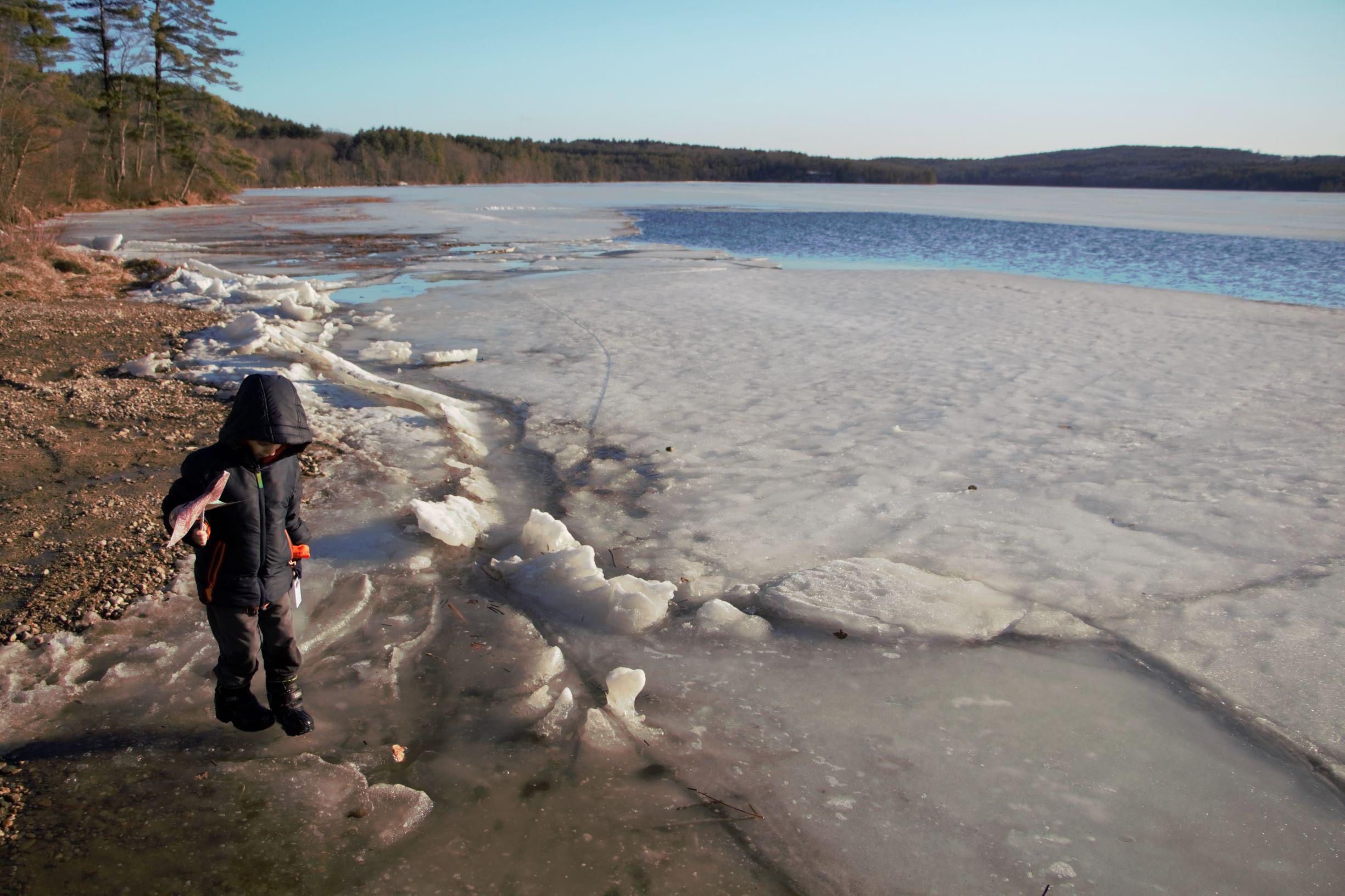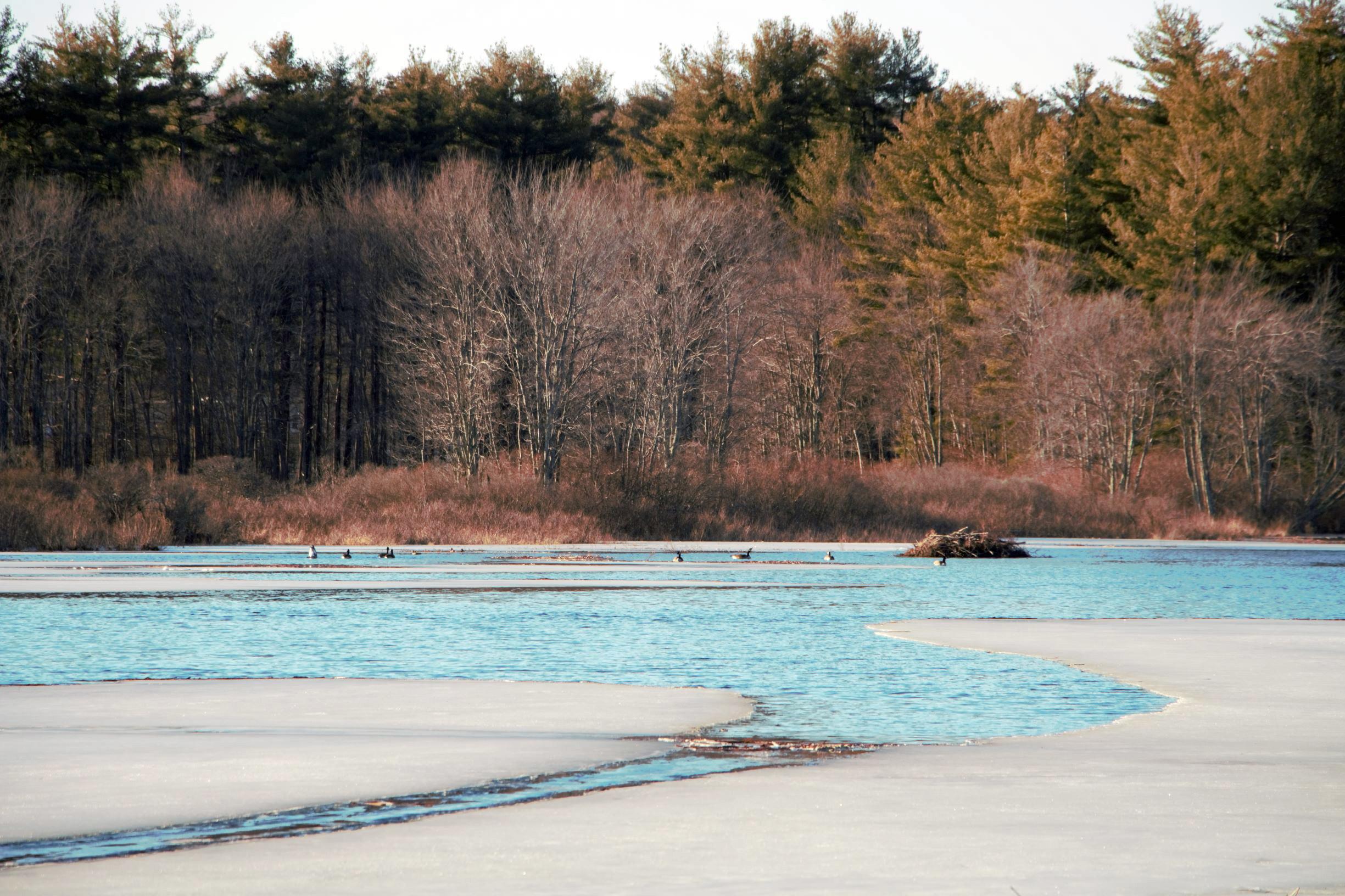- Tags:
- Wildlife,
- Recreation

Jonah Berry took his pinwheel for a spin in the early spring wind on March 10 at Lake Massabesic. Despite the sunshine, many trails and parks are still frozen and can be tricky to navigate without preparation. (Photo: Anna Berry)
During a year when humans joined animals in winter hibernation, signs of spring have never been more welcome. Daylight saving time and the coming vernal equinox bring extra light to evenings and birds back to budding trees.
Although I’ve skied and hiked with my family this winter, I look forward to the ease of sunny days — when I won’t need to force my children into tight layers of warm clothes or haul heavy gear. I’m eager to exit isolation and feel the wind on my skin.
Still, as I recently discovered, spring adventures have unique challenges.
Recreating responsibly means considering mud, masks, and more as you explore the outdoors in March and April.
As Forest Society naturalist Dave Anderson explains about mud season, the health of soil is at stake. Vulnerable, wet soil needs to be protected from compaction and pooling of water where drainage is poor. Compaction of the fine roots of trees and shrubs is more likely as frost comes out of the ground.
What does that mean for local trails, which have already seen a year of increased foot and bike traffic? Conservation organizations like the Forest Society welcome visitors to protected spaces but also provide education to ensure hikers “leave no trace” and encourage use of the most well-maintained, hardened trails.
Leave No Trace is a set of principles that anyone can use to minimize their impact on the environment. Principle No. 2 is to travel and camp on “durable surfaces” in order to move through natural spaces without damaging the land and watershed. For hikers, that may mean walking through mud, staying on the center of a path to avoid widening a trail.
My 5-year-olds don’t need to be reminded to embrace the mud — it’s instinctive to splash through puddles, jump over ice and climb over rocks.
Nature needs mud too, Anderson says.
“Mud is actually a sought-after habitat feature later in April and May for use as nest building material by several birds — particularly phoebes and robins and the more common swallows: barn swallows and tree swallows,” he says.
And, moths and butterflies like the common mourning cloak gather at the muddy edges of meltwater pools in search of mineral salts, Anderson adds.
For humans, with spring just beginning to unfold, trails could be covered in snow, ice or mud depending on the day and the elevation — so don’t put away your micro-spikes yet. That’s also why “plan ahead and prepare,” the first principle of Leave No Trace, is critical this time of year.
I was reminded of that principle last week when I headed outside to enjoy the warmer temperatures with my family. We planned to walk one of the trails at Lake Massabesic in Manchester and brought masks, extra pairs of socks, and snacks, among other gear.

While we didn’t get to look for green stems popping up in the forest, we did spot Canadian geese in a patch of open water and spun handmade pinwheels in the breeze. And, one of my sons found a way to soak himself up to his knees. Lesson learned: next time around, I’ll bring even more socks.
Responsible recreation
- Stay local-ish and know before you go.
Traveling around the state is safer than last spring, thanks to a statewide mask mandate and ongoing vaccinations. However, neighboring states may still have restrictions on visitors. And, at some popular hiking destinations, like Mount Monadnock, the requirement to register in advance hasn’t changed.
- Be prepared for winter conditions.
There’s still time for more snow, so keep tabs on outdoor spaces with plowed parking and watch out for winter roadside parking bans. Trail conditions can include snow, ice and mud. You can find a list of the Forest Society’s forest reservations with plowed parking — plus a list of cold weather essentials — at forestsociety.org/winterhiking.
- Stay on the trail.
Spring hiking may mean walking through mud to avoid widening a trail. Follow the principles of Leave No Trace — including packing out human and animal waste — to protect natural spaces.
- It’s a new season — and a new year.
If you haven’t ventured outside yet in 2021, remember that it’s a new year for the Hike Safe card (see nhfishandgame.com/HikeSafe.aspx) and NH State Parks season passes, which run on the calendar year. Support the trail maintenance and land trust organizations that protect your favorite places with a membership or donation. Trail use may be free, but keeping these spaces open is not.
Anna Berry is the digital outreach manager for the Forest Society.
